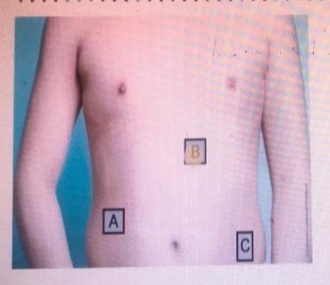ATI RN
ATI RN Adult Medical Surgical 2023 Questions Questions
Extract:
Question 1 of 5
A nurse is admitting a client who has arthritic pain and reports taking ibuprofen several times daily for 3 years. Which of the following tests should the nurse monitor?
Correct Answer: B
Rationale: The correct answer is B: Stool for occult blood. Ibuprofen is a nonsteroidal anti-inflammatory drug (NSAI
D) that can cause gastrointestinal bleeding, leading to occult blood in the stool. Monitoring stool for occult blood helps in detecting any gastrointestinal bleeding early. Serum calcium (
A) is not typically affected by long-term ibuprofen use. Fasting blood glucose (
C) is not directly related to ibuprofen use. Urine for white blood cells (
D) is not relevant in this scenario.
Extract:
Medical History: Cerebrovascular accident (CVA) 2 years ago, Coronary artery disease, Hypertension, Hyperlipidemia. A nurse is reviewing the client's medical record. After reviewing the medical history, the nurse must determine which of the following actions to take.
Question 2 of 5
For each potential provider’s prescription, the nurse must select if the action is Anticipated, Nonessential, or Contraindicated for the client.
| Potential Prescription | Anticipated | Non-essential | Contraindicated |
|---|---|---|---|
| Encourage the client to cough | |||
| Elevate the head of the bed | |||
| Assist the client to the bathroom | |||
| Decrease oxygen to 1.5 L/min via nasal cannula | |||
| Keep the client’s head in a midline position | |||
| Initiate seizure precautions |
Correct Answer: B, A, C, A
Rationale: The correct answer is based on the rationale below:
1. Elevate the head of the bed (
B): This action is Anticipated as it helps prevent aspiration and promotes optimal respiratory function.
2. Encourage the client to cough (
A): Also Anticipated as coughing helps clear secretions and maintain airway patency.
3. Assist the client to the bathroom (
C): This is Non-essential unless there are specific concerns about the client's mobility or urgency.
4. Decrease oxygen to 1.5 L/min via nasal cannula (
A): Contraindicated as it may compromise oxygenation, especially without proper assessment and orders.
Other choices:
- Keeping the client's head in a midline position (E) is not provided in the question stem, so it cannot be evaluated.
- Initiating seizure precautions (F) is not relevant to the client's immediate care based on the information given
Extract:
Question 3 of 5
A nurse is preparing to receive a client from surgery following a transverse colon resection with colostomy placement. The nurse should expect to assess the stoma at which of the following locations? (You will find hot spots to select in the artwork below. Select only the hot spot that corresponds to your answer.)

Correct Answer:
Rationale:
Correct
Answer: B
Rationale: The correct location to assess the stoma following a transverse colon resection with colostomy placement is at location B, which is in the left lower quadrant. This is because the transverse colon is typically located in the upper abdomen, and the stoma would be brought out at the most dependent portion of the colon, which is in the left lower quadrant. Assessing the stoma in this location allows the nurse to monitor for proper stoma function and potential complications.
Summary:
A: Incorrect - Location A is in the right upper quadrant, which is not the typical site for a stoma following a transverse colon resection.
C: Incorrect - Location C is in the left upper quadrant, which is also not the typical site for a stoma after this surgery.
D, E, F, G: Not applicable as they are not relevant to the question.
Question 4 of 5
A nurse is assessing a client who has a urinary catheter. The nurse notes the client's IV tubing is kinked and the urinary catheter bag is lying next to the client in bed. The nurse should identify that the client is at risk for which of the following conditions?
Correct Answer: B
Rationale: The correct answer is B: Infection. When IV tubing is kinked, it can lead to a backflow of urine from the catheter into the tubing, increasing the risk of contamination and subsequent urinary tract infection. Additionally, when the urinary catheter bag is lying next to the client in bed, there is a higher chance of accidental contamination. Infections can lead to serious complications and require prompt intervention. Neurogenic bladder (
A) is related to nerve damage affecting bladder control, not directly related to the current situation. Skin breakdown (
C) may occur due to prolonged contact with urine but is not the immediate concern here. Phlebitis (
D) is inflammation of a vein, not directly linked to the urinary catheter issue.
Question 5 of 5
A nurse is reviewing the medical record of a client who has nephrotic syndrome. Which of the following findings should the nurse expect?
Correct Answer: B
Rationale: The correct answer is B: Proteinuria. In nephrotic syndrome, there is increased permeability of the glomerular filtration membrane, leading to the loss of protein in the urine, specifically albumin. Hyperalbuminemia (choice
A) is incorrect as albumin is lost in the urine. Decreased serum lipid levels (choice
C) are incorrect because nephrotic syndrome is associated with hyperlipidemia due to altered lipid metabolism. Decreased coagulation (choice
D) is incorrect as nephrotic syndrome is actually associated with a hypercoagulable state due to loss of anticoagulant proteins in the urine.
